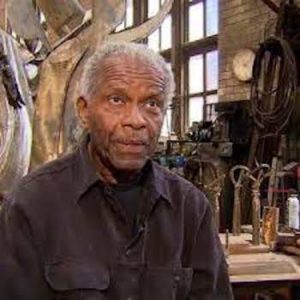
Richard Hunt
*Richard Hunt was born on this date in 1935. He is a Black sculptor artist.
Richard Howard Hunt was born on Chicago's South Side. At eleven years old, he and his younger sister Marian moved to Galesburg, Illinois, where he spent most of his time in Chicago. From an early age, he was interested in the arts, as his mother, an artist and librarian, would bring him to performances by local opera companies that sang classical repertoires of Mozart, Rossini, Verdi, and Handel.
As a young boy, Hunt began to show enthusiasm and talent in artistic disciplines such as drawing, painting, and sculpture, an interest that grew increasingly as he got older. Hunt was inspired to pursue his career in the arts because his family appreciated art, and he clearly said, "My mom was supportive, and dad was tolerant." In the seventh grade, Hunt became interested in art at the Chicago Junior School of Art Institute. Hunt also acquired business sense and awareness of social issues from working for his father in a barbershop.
As a teenager, Hunt began his work in sculpture, working in clay and carvings. While his work started in a makeshift studio in his 1950 bedroom, he eventually built a basement studio in his father's barbershop. Hunt not only embraced the medium of metal and the techniques of sculpting but studied non-art subjects at the University of Chicago and the University of Illinois before entering the Art Institute of Chicago. The non-art subjects that Hunt first worked on were objects he found. He was once interested in Surrealism, where he experimented with assembling broken machine parts and metals from the junkyard, such as car bumpers, and reshaping them into organic forms.
Hunt studied at the Art Institute of Chicago from 1953 to 1957, focusing on welding sculptures but also studying lithography. Hunt began experimenting with materials and sculpting techniques, influenced heavily by progressive twentieth-century artists. Hunt was inspired to focus on sculpture because of the 1950s exhibition Sculpture of the Twentieth Century, held at the Art Institute of Chicago in 1953. The Sculpture of the Twentieth Century includes works of Pablo Picasso, Julio Gonzalez, and David Smith. At the exhibition, Hunt saw various artworks of welded metal for the first time. Hunt was also inspired and paid respect to European sculptor Duchamp-Villon, whose 1914 bronze "Horse" was instructional. Seeing these artists' works led Hunt to create abstract shapes by welding metal.
His earliest works were more figural than his later ones and usually represented classical themes. Hunt began exhibiting his sculptures nationwide while still a student at the School of the Art Institute of Chicago. As a Junior, his piece “Arachne” was purchased by the Museum of Modern Art in New York. He received a B.A.E. from the Art Institute of Chicago in 1957. Upon graduating, Hunt was awarded the James Nelson Raymond Foreign Travel Fellowship and continued his studies in England, France, Italy, and Spain. His time abroad solidified his belief that metal was the definitive medium of the twentieth century. He served in the United States Army from 1958 to 1960.
He became the youngest exhibiting artist at the 1962 Seattle World's Fair. In the 1960s and 1970s, Hunt used car junkyards as his quarries and turned bumpers and fenders into abstract, welded sculptures. Hunt also focused on the linear-spatial arrangement of his materials, where he followed Julio Gonzalez's footsteps into three-dimensional structures. This experimentation garnered a critically positive response from the art community. Hunt was exhibited at the Artists of Chicago and Vicinity Show and the American Show, where the Museum of Modern Art purchased a piece for its collection.
He was the youngest artist to exhibit at the 1962 Seattle World's Fair, a major international survey exhibition of modern art. Hunt received his first sculpture commission in 1967, known as Play, which was commissioned by the State of Illinois Public Art Program. The making of this sculpture led him to many other public commissions and was considered to be his second career as a public sculptor. Hunt has completed more public sculptures than any other artist in the country. As of January 20, 2015, Hunt has created over 125 sculptures for public display in the United States. His signature pieces include Jacob's Ladder at the Carter G. Woodson Library in Chicago and Flintlock Fantasy in Detroit.
President Lyndon Johnson appointed him one of the first artists to serve on the National Endowment for the Arts governing board. He also served on boards of the Smithsonian Institution. From 1980 to 1988, Hunt served as Commissioner of the Smithsonian Institution's National Museum of American Art. From 1994 to 1997, Hunt served on the Smithsonian Institution's National Board of Directors. Hunt is the recipient of numerous awards and honorary degrees. In 1974, Hunt acquired a deactivated electrical substation near northern Chicago and repurposed it into a metal welding sculpture studio. The station had a crane, convenient for moving large sculpture pieces, and a spacious 40-foot ceiling.
While handling the metal, Hunt works with two assistants. Hunt describes metalworks as "a free play of forms evolving, developing and contrasting with one another." Hunt has continued to experiment throughout his successful career, employing a wide range of sculptural techniques. Through his work, Hunt often comments on contemporary social and political issues.
To become a jeweler, seamstress, textile/fine artist
To be an Artist